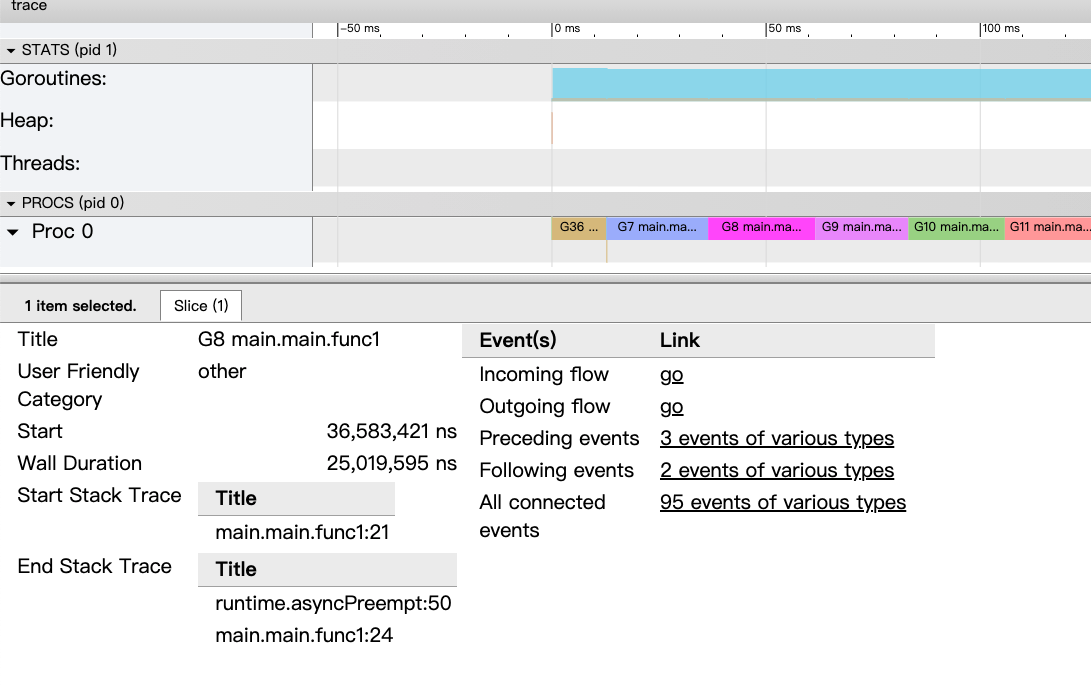在 Go 的 1.14 版本之前抢占试调度都是基于协作的,需要自己主动的让出执行,但是这样是无法处理一些无法被抢占的边缘情况。例如:for 循环或者垃圾回收长时间占用线程,这些问题中的一部分直到 1.14 才被基于信号的抢占式调度解决。
下面我们通过一个例子来验证一下1.14 版本和 1.13 版本之间的抢占差异:
package main import ( "fmt" "os" "runtime" "runtime/trace" "sync" ) func main() { runtime.GOMAXPROCS(1) f, _ := os.Create("trace.output") defer f.Close() _ = trace.Start(f) defer trace.Stop() var wg sync.WaitGroup for i := 0; i < 30; i++ { wg.Add(1) go func() { defer wg.Done() t := 0 for i:=0;i<1e8;i++ { t+=2 } fmt.Println("total:", t) }() } wg.Wait() }这个例子中会通过 go trace 来进行执行过程的调用跟踪。在代码中指定 runtime.GOMAXPROCS(1)设置最大的可同时使用的 CPU 核数为1,只用一个 P(处理器),这样就确保是单处理器的场景。然后调用一个 for 循环开启 10 个 goroutines 来执行 func 函数,这是一个纯计算且耗时的函数,防止 goroutines 空闲让出执行。
下面我们编译程序分析 trace 输出:
$ go build -gcflags "-N -l" main.go -N表示禁用优化 -l禁用内联 $ ./main然后我们获取到 trace.output 文件后进行可视化展示:
$ go tool trace -http=":6060" ./trace.output Go1.13 trace 分析
从上面的这个图可以看出:
因为我们限定了只有一个 P,所以在 PROCS 这一栏里面只有一个 Proc0;
我们在 for 循环里面启动了 30 个 goroutines ,所以我们可以数一下 Proc0 里面的颜色框框,刚好30 个;
30 个 goroutines 在 Proc0 里面是串行执行的,一个执行完再执行另一个,没有进行抢占;
随便点击一个 goroutines 的详情栏可以看到 Wall Duration 为 0.23s 左右,表示这个 goroutines 持续执行了 0.23s,总共 10 个 goroutines 执行时间是 7s 左右;
切入调用栈 Start Stack Trace 是 main.main.func1:20,在代码上面是 func 函数执行头: go func() ;
切走调用栈 End Stack Trace 是 main.main.func1:26,在代码上是 func 函数最后执行打印:fmt.Println("total:", t);
从上面的 trace 分析可以知道,Go 的协作式调度对 calcSum 函数是毫无作用的,一旦执行开始,只能等执行结束。每个 goroutine 耗费了 0.23s 这么长的时间,也无法抢占它的执行权。
Go 1.14 以上 trace 分析
在 Go 1.14 之后引入了基于信号的抢占式调度,从上面的图可以看到 Proc0 这一栏中密密麻麻都是 goroutines 在切换时的调用情况,不会再出现 goroutines 一旦执行开始,只能等执行结束这种情况。
上面跑动的时间是 4s 左右这个情况可以忽略,因为我是在两台配置不同的机器上跑的(主要是我闲麻烦要找两台一样的机器)。
下面我们拉近了看一下明细情况:

通过这个明细可以看出:
这个 goroutine 运行了 0.025s 就让出执行了;
切入调用栈 Start Stack Trace 是 main.main.func1:21,和上面一样;
切走调用栈 End Stack Trace 是 runtime.asyncPreempt:50 ,这个函数是收到抢占信号时执行的函数,从这个地方也能明确的知道,被异步抢占了;
分析 抢占信号的安装runtime/signal_unix.go
程序启动时,在runtime.sighandler中注册 SIGURG 信号的处理函数runtime.doSigPreempt。
initsig
func initsig(preinit bool) { // 预初始化 if !preinit { signalsOK = true } //遍历信号数组 for i := uint32(0); i < _NSIG; i++ { t := &sigtable[i] //略过信号:SIGKILL、SIGSTOP、SIGTSTP、SIGCONT、SIGTTIN、SIGTTOU if t.flags == 0 || t.flags&_SigDefault != 0 { continue } ... setsig(i, funcPC(sighandler)) } }在 initsig 函数里面会遍历所有的信号量,然后调用 setsig 函数进行注册。我们可以查看 sigtable 这个全局变量看看有什么信息:
var sigtable = [...]sigTabT{ /* 0 */ {0, "SIGNONE: no trap"}, /* 1 */ {_SigNotify + _SigKill, "SIGHUP: terminal line hangup"}, /* 2 */ {_SigNotify + _SigKill, "SIGINT: interrupt"}, /* 3 */ {_SigNotify + _SigThrow, "SIGQUIT: quit"}, /* 4 */ {_SigThrow + _SigUnblock, "SIGILL: illegal instruction"}, /* 5 */ {_SigThrow + _SigUnblock, "SIGTRAP: trace trap"}, /* 6 */ {_SigNotify + _SigThrow, "SIGABRT: abort"}, /* 7 */ {_SigPanic + _SigUnblock, "SIGBUS: bus error"}, /* 8 */ {_SigPanic + _SigUnblock, "SIGFPE: floating-point exception"}, /* 9 */ {0, "SIGKILL: kill"}, /* 10 */ {_SigNotify, "SIGUSR1: user-defined signal 1"}, /* 11 */ {_SigPanic + _SigUnblock, "SIGSEGV: segmentation violation"}, /* 12 */ {_SigNotify, "SIGUSR2: user-defined signal 2"}, /* 13 */ {_SigNotify, "SIGPIPE: write to broken pipe"}, /* 14 */ {_SigNotify, "SIGALRM: alarm clock"}, /* 15 */ {_SigNotify + _SigKill, "SIGTERM: termination"}, /* 16 */ {_SigThrow + _SigUnblock, "SIGSTKFLT: stack fault"}, /* 17 */ {_SigNotify + _SigUnblock + _SigIgn, "SIGCHLD: child status has changed"}, /* 18 */ {_SigNotify + _SigDefault + _SigIgn, "SIGCONT: continue"}, /* 19 */ {0, "SIGSTOP: stop, unblockable"}, /* 20 */ {_SigNotify + _SigDefault + _SigIgn, "SIGTSTP: keyboard stop"}, /* 21 */ {_SigNotify + _SigDefault + _SigIgn, "SIGTTIN: background read from tty"}, /* 22 */ {_SigNotify + _SigDefault + _SigIgn, "SIGTTOU: background write to tty"}, /* 23 */ {_SigNotify + _SigIgn, "SIGURG: urgent condition on socket"}, /* 24 */ {_SigNotify, "SIGXCPU: cpu limit exceeded"}, /* 25 */ {_SigNotify, "SIGXFSZ: file size limit exceeded"}, /* 26 */ {_SigNotify, "SIGVTALRM: virtual alarm clock"}, /* 27 */ {_SigNotify + _SigUnblock, "SIGPROF: profiling alarm clock"}, /* 28 */ {_SigNotify + _SigIgn, "SIGWINCH: window size change"}, /* 29 */ {_SigNotify, "SIGIO: i/o now possible"}, /* 30 */ {_SigNotify, "SIGPWR: power failure restart"}, /* 31 */ {_SigThrow, "SIGSYS: bad system call"}, /* 32 */ {_SigSetStack + _SigUnblock, "signal 32"}, /* SIGCANCEL; see issue 6997 */ /* 33 */ {_SigSetStack + _SigUnblock, "signal 33"}, /* SIGSETXID; see issues 3871, 9400, 12498 */ ... }
